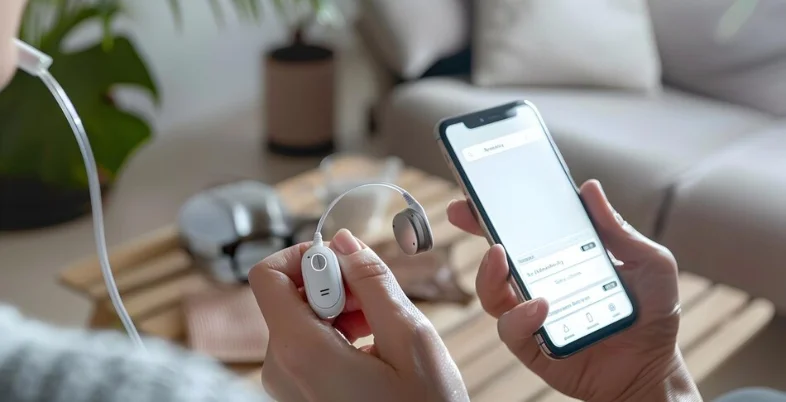The advancement of technology has dramatically influenced every facet of modern life, including how we perceive sound. Smart sound devices have emerged as one of the most significant innovations, altering the way we hear and interact with the auditory world. With features driven by artificial intelligence (AI) and sophisticated sound processing, these devices are making sound clearer, more personalized, and more immersive. From everyday listening to specialized solutions for those with hearing impairments, the transformation is profound.

The Evolution of Smart Sound Technology
Sound technology has come a long way from the days of simple amplification. What once involved rudimentary methods of boosting volume has now evolved into intricate systems capable of understanding and adapting to the nuances of sound. Smart sound devices use AI to process and interpret sound in real time, offering users an optimized experience that was once unimaginable.
These devices are equipped with sensors and algorithms that analyze the surrounding environment. Whether it’s filtering out background noise, amplifying specific frequencies, or even learning user preferences over time, smart sound technology has completely redefined the auditory experience. The adaptability and customization offered by these devices are leading to a more nuanced and tailored approach to sound.
Personalized Listening Experiences
One of the most remarkable aspects of smart sound devices is the ability to provide personalized listening experiences. AI-powered systems can learn a user’s preferences and automatically adjust sound settings to suit their unique needs. For example, someone who enjoys listening to music in a quiet room may prefer a different sound profile than someone in a noisy café. The device can detect these conditions and make real-time adjustments, ensuring optimal sound quality in any situation.
This level of customization isn’t limited to just volume or clarity. Advanced devices can analyze different types of sound, from speech to music, and adjust accordingly. Speech enhancement technologies are particularly useful for deaf and hoh customers, as they isolate and amplify voices while reducing ambient noise. This makes conversations clearer and more comfortable, even in busy or loud environments.
Noise-Canceling Capabilities and Ambient Awareness
Advanced sound devices have revolutionized how we experience audio by introducing innovative features that create a more immersive and focused listening experience. These advancements allow users to enjoy sound in any environment without being overwhelmed by background noise. Here are key aspects of this evolution:
Active Noise Cancellation (ANC): This technology uses built-in microphones and complex algorithms to detect external noise and then generate soundwaves that cancel out those noises. This feature is especially beneficial for individuals in noisy environments like busy offices, public transportation, or city streets. ANC lets users focus on their music, podcasts, or calls without distractions, providing a more serene listening experience even in chaotic surroundings.
Adaptive Noise Management: Unlike traditional noise-canceling technology that offers a blanket approach, newer devices provide adaptive noise management. This means the device can automatically adjust the level of noise cancellation based on the surrounding environment. Whether moving from a quiet park to a noisy café or stepping into a crowded subway, the device adapts in real-time to offer consistent sound quality.
Blended Soundscapes: Some devices blend noise cancellation with ambient sound awareness, creating a balanced auditory environment. While noise cancellation blocks unwanted sounds, ambient awareness allows essential noises like voices, alarms, or traffic to filter through. This feature is particularly useful for outdoor activities or commuting, where users need to stay alert to their surroundings without sacrificing sound quality.
These features make modern sound devices smarter and more intuitive, offering users the ability to enjoy high-quality sound while maintaining control over how much of the surrounding noise they hear or block out.
Connectivity and Integration with Everyday Devices
Another key benefit of smart sound devices is their seamless integration with other technology. Most of these devices are equipped with Bluetooth, Wi-Fi, or other connectivity options that allow them to sync with smartphones, laptops, and even home entertainment systems. This level of connectivity makes it easier than ever to manage multiple devices, stream music, or make phone calls directly from the sound device itself.
The integration with smart home systems also opens up new possibilities. Some devices can be controlled via voice assistants like Alexa or Google Assistant, enabling hands-free operation. This allows users to adjust sound settings, change tracks, or even check the weather, all without having to reach for their phone or tablet.
For individuals with hearing impairments, this connectivity is even more valuable. Smart sound devices can sync with apps that allow for remote control of settings, as well as health apps that monitor hearing levels and provide feedback. This integration creates a more holistic approach to hearing health, offering users not just improved sound quality, but also valuable insights into their auditory wellbeing.
AI’s Role in Sound Processing

Artificial intelligence plays a central role in how these devices operate. By analyzing sound input in real time, AI can adapt to changes in the environment, whether it’s a sudden increase in background noise or a shift in the type of sound being played. This capability is what sets smart sound devices apart from traditional audio equipment.
AI also enables predictive sound processing, where the device can anticipate what the user will want to hear next. For instance, if someone is walking from a quiet park into a bustling café, the device may adjust its noise cancellation or volume settings automatically, without the user having to intervene. This intuitive response to changes in the environment makes the listening experience smoother and more enjoyable.
Additionally, AI can help identify and amplify specific sounds, such as speech. This is particularly useful in environments with lots of background noise, where distinguishing between voices and other sounds can be difficult. AI algorithms can isolate these sounds, making conversations clearer and more intelligible, even in challenging acoustic conditions.
Expanding Accessibility Through Technology
For individuals with hearing impairments, smart sound devices have been life-changing. Traditional hearing aids, while helpful, often struggle in noisy environments or require constant manual adjustments. Smart devices overcome these challenges by using AI to adjust settings automatically based on the user’s needs.
Biometric sensors are also being integrated into some smart devices, providing a deeper level of customization. These sensors can detect subtle changes in a user’s environment or health, such as stress levels or heart rate, and adjust sound settings accordingly. For example, in a high-stress situation, the device might reduce the volume of background noise to help the user stay calm and focused.
Look into the Future of Smart Sound Devices
Given that technology is improving fast, the future of smart sound devices looks brilliant. The elements we are likely to look forward to in the near future are more refined sound quality, greater integrative capability with other technologies, and even more personification. AI will proceed with great significance in enhancing the quality of sound and new ways of offering interaction with the world around us.
Smart audio devices also will be more accessible for their owners: affordable and user-friendly. When AI technologies get more mature, we may get a new generation of smart devices that can learn how the user behaves in even more sophisticated ways, creating a truly intuitive and natural listening experience.
Be it for the casual listener or those with very particular aural needs, smart sound devices are irrevocably revolutionizing the way we hear. With AI at the helm, such inventions will only continue to improve our aural experiences, making sound clearer, more immersive, and tailored than ever before.






